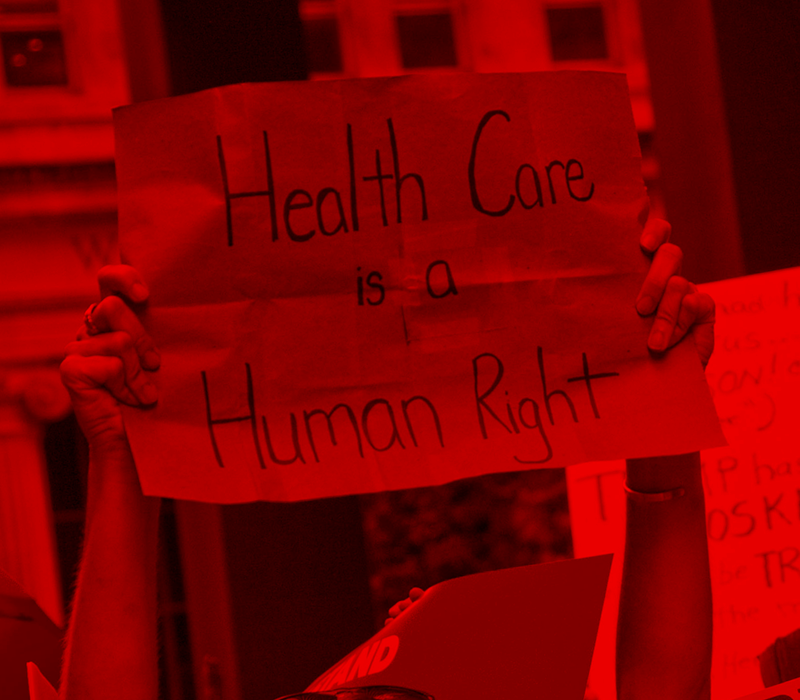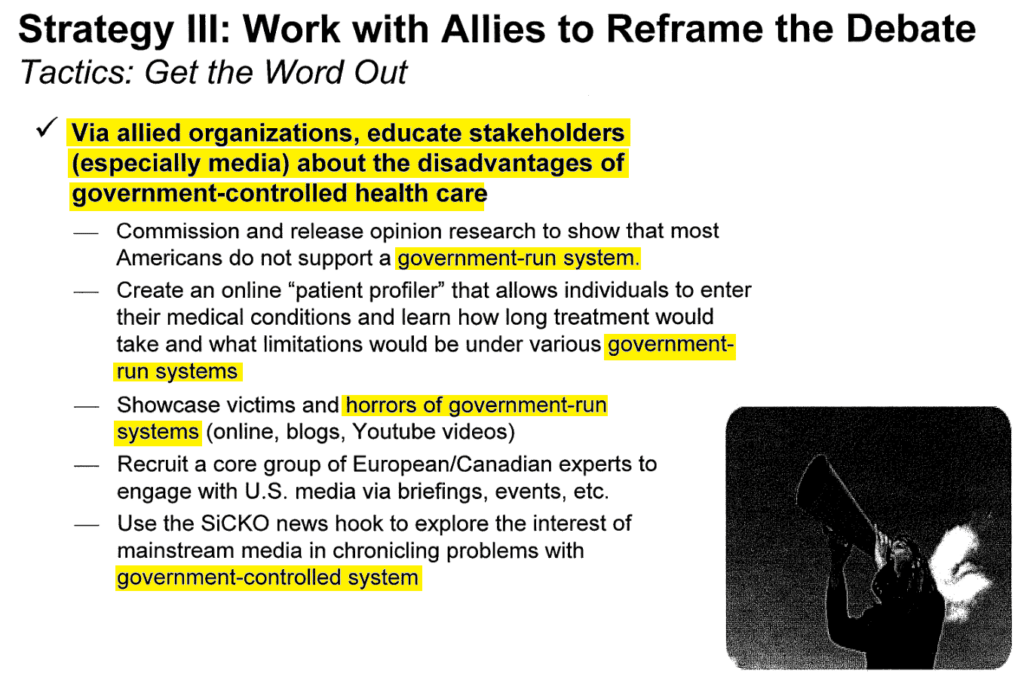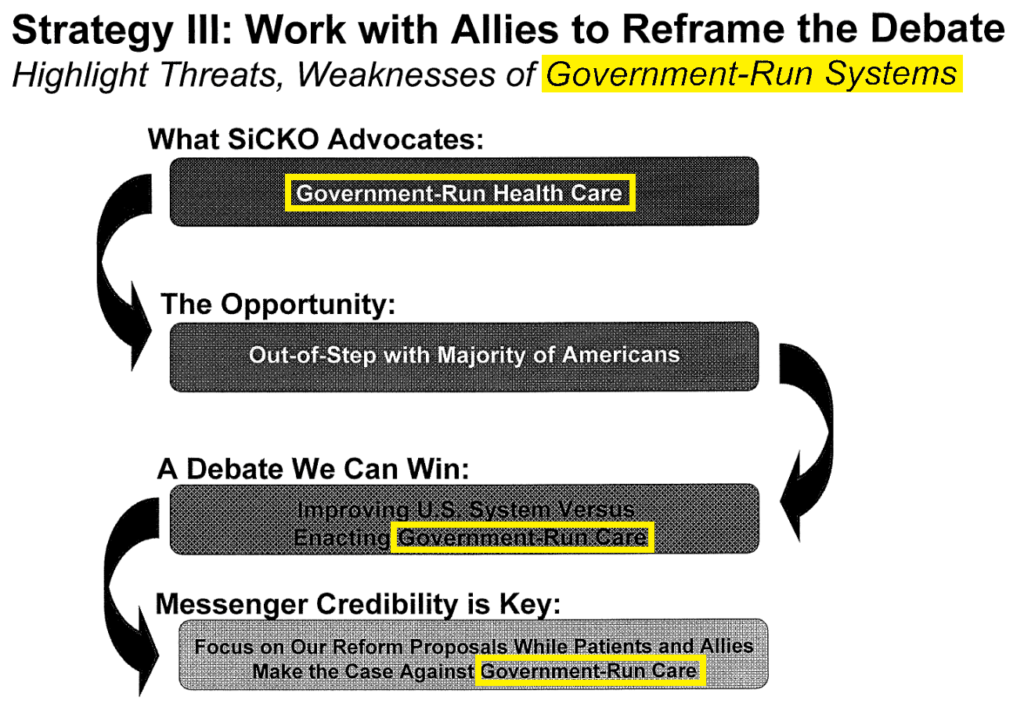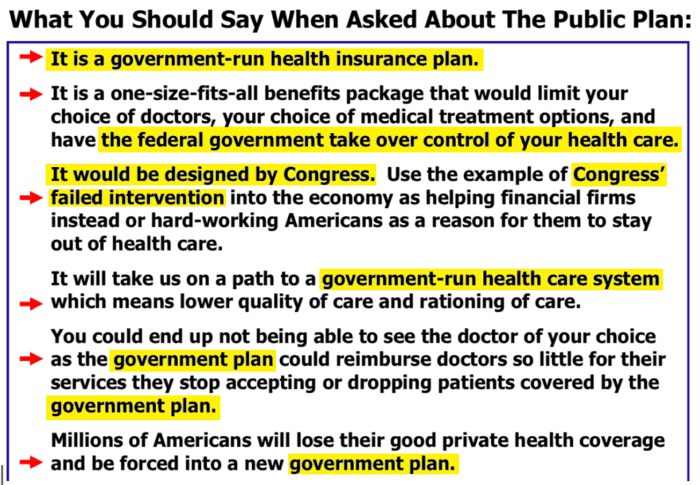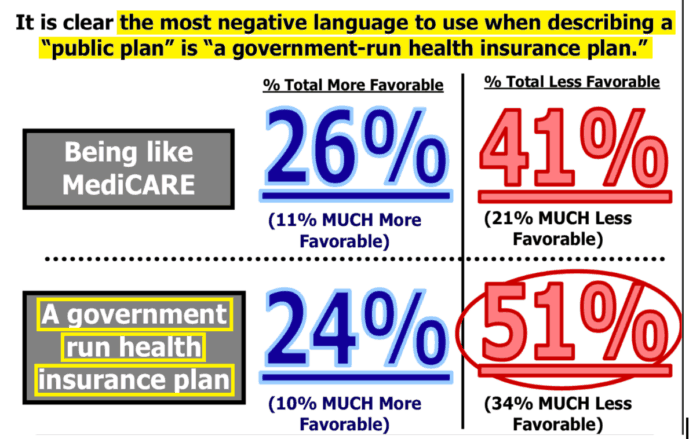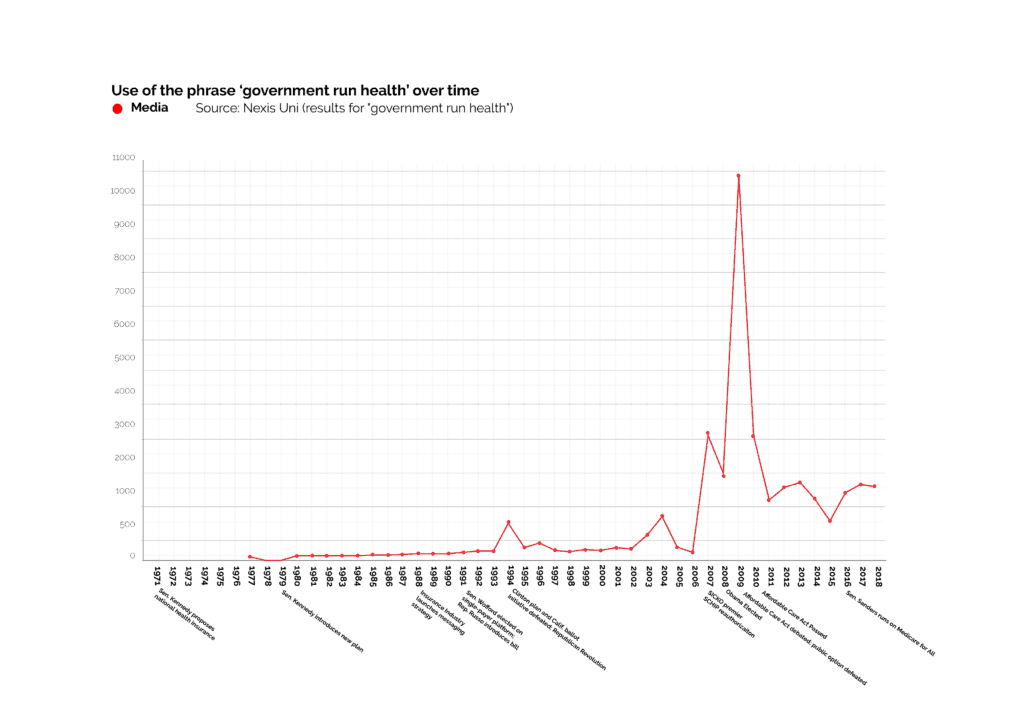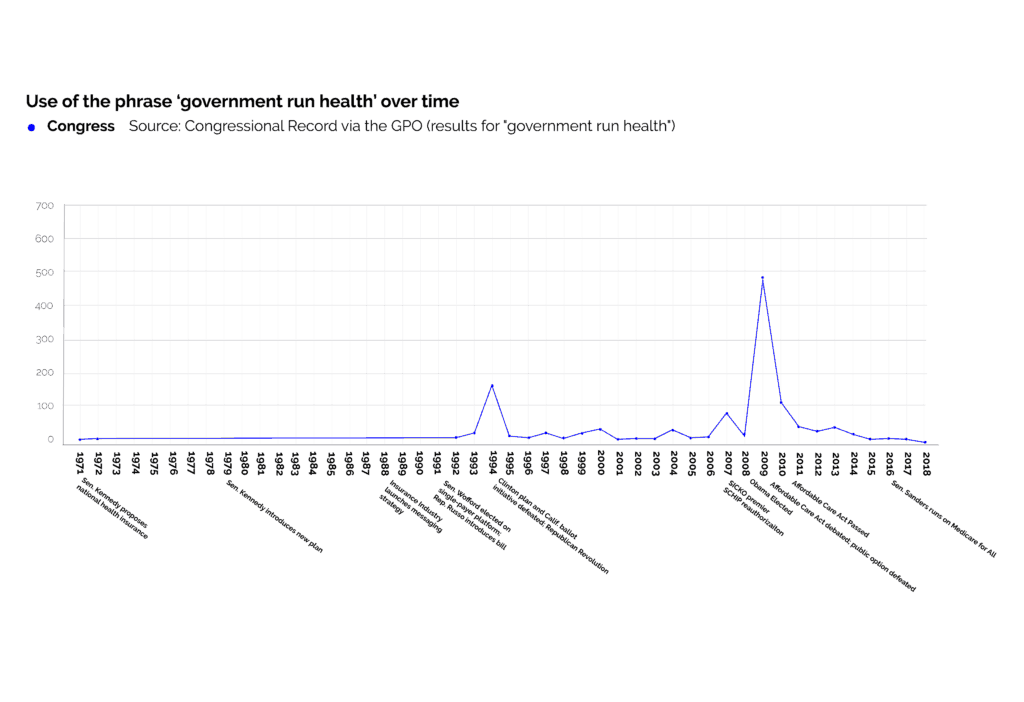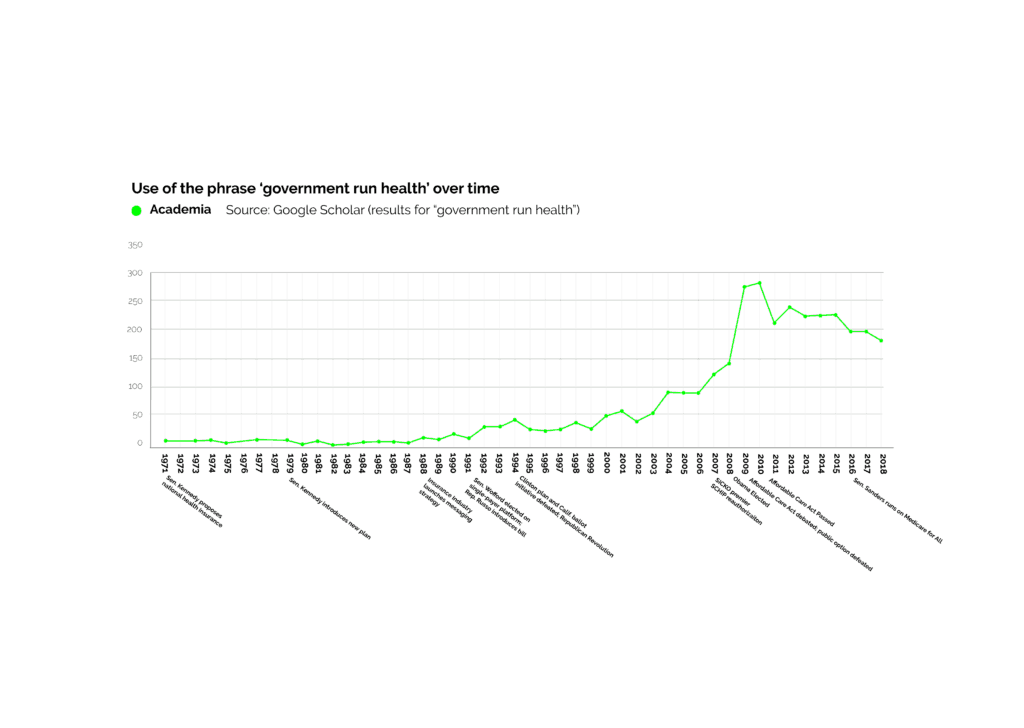Parroting the Right: How Media and Polling Company Adoption of Insurance Industry Spin Warps Democracy

by Ben Palmquist, June 2019
Mainstream media and public-opinion polls commonly state that the country has a choice between government and private insurance. This portrayal is inherently biased because it invokes government control while rendering insurance companies invisible, warping democratic discourse and policy-making. As leaked memos and decades of news reports and polls reveal, most journalists and pollsters only adopted this framing after the health insurance industry crafted it and, along with partisan strategists and right-wing think tanks and media, pressed it into common use. To balance their reporting, nonpartisan media, polling, and policy organizations must drop the insurance industry’s biased framing and instead contrast private with public insurance or name the role of both government and insurance companies in the health care system.
Contents
II. The Strategic Construction of Anti-Government Spin
A. Construction of Spin by the Insurance Industry
B. Weaponization by Republican and Libertarian Strategists
C. Mainstreaming by Right-Wing Strategists, Think Tanks, and Media
III. Mainstream Adoption of Insurance Industry Spin
B. Adoption by Public-Opinion Polls
IV. Moving from Biased to Balanced Language
Introduction
Spiraling health care costs and a wave of popular support behind Medicare for All have put publicly financed health insurance back on the nation’s agenda. The Democratic Party is no longer debating whether to expand public insurance programs, but by how much. It is no surprise that the health insurance industry and right-wing think tanks and media are waging an all-out counter-attack on Medicare for All and public insurance options, positioning themselves as staunch opponents of “government-run health care.” Less noticed is the striking degree to which the health insurance industry’s precise language and framing has been adopted by the mainstream media and polling organizations in recent years.
Since the health care battles of the early 1990s and especially 2007-2010, the New York Times, Washington Post, CNN, Politico, Vox, and every other major news organization have repeatedly framed health care politics as a choice between government-run or private health insurance. Gallup, Harvard’s T.H. Chan School of Public Health, Hill-HarrisX, Ipsos, Kaiser Family Foundation, NORC, Quinnipiac, Robert Wood Johnson Foundation, YouGov, and other polling organizations all survey the public’s preferences between government and private insurance. The think tanks Progressive Policy Institute and Third Way have strongly adopted this language, and Commonwealth Fund, Kaiser Family Foundation, Committee for a Responsible Federal Budget, and Urban Institute have occasionally used it.
One problem with this framing is that describing the entire health care system as “government” health care is simply wrong. Medicare, Medicaid, public options, and Medicare for All are all publicly financed insurance programs that leave most of the health care system—including hospitals, physician practices, and drug and medical device manufacturers—in private hands. A third of Medicare plans and two-thirds of Medicaid plans are also run by private insurance companies.
But not only is the use of this “government” phrasing sometimes used inaccurately: it is also fundamentally biased. By drawing a contrast between “government” and “private” insurance, the media and polling organizations explicitly invoke government control of public insurance while rendering private insurance companies invisible. Rather than providing a balanced comparison of public and private health care (employing two symmetrically abstract terms) or government-run and corporate-run insurance (explicitly naming actors), the media and polling organizations are employing a linguistically and symbolically skewed comparison. This politicizes their reporting and analysis, misrepresents and manipulates public opinion, and warps democratic discourse and policymaking.
This language was not adopted by chance. As this report details, a series of leaked strategy memos and decades of news articles and polls reveals that the word “government” was rarely used in surveys before the 1990s or in the mainstream press before 2007 as way to define publicly financed and administered health care. Only after the health insurance industry and a small cadre of Republican strategists crafted and pushed this phrasing for their own financial and electoral gain did the press and pollsters widely adopt this terminology.
Politically independent journalists, media and polling organizations, and think tanks have an obligation to drop the insurance industry’s biased, politicized framing of health care in order to provide people with an accurate and balanced picture of the health care choices facing the country and to properly represent the public’s opinions and preferences. They must replace references to “government” and “government-run” insurance and health care with “public” or, alternatively, contrast “government-run” insurance with “corporate-run” insurance.
In the first section of this report, we trace how this biased framing was strategically constructed by the health insurance industry and mainstreamed by the industry along with other business lobbies, Republican strategists, and right-wing think tanks and media. In the second, we reveal how the mainstream media and public-opinion polls adopted this language following the insurance industry’s messaging campaign. In the third, we offer specific recommendations on how journalists, editors, and public-opinion pollsters can balance their language.
I. The Strategic Construction of Anti-Government Spin
A. Construction of Spin by the Insurance Industry
Though there is a long history in American politics of opponents slandering proposals for universal health care as “socialized medicine,” before the 1990s, the term “government” was rarely used to define publicly financed health care programs. Public officials, journalists, academics, pollsters and others tended to refer to both public and private insurance programs without explicitly naming the insurer. They usually called publicly administered insurance “national health insurance,” “a national health program,” “single payer,” “Canadian-style health insurance,” “universal health insurance coverage,” or simply by the name of the program (Medicare, for example).
In 1989, that began to change. Rising health care costs, a recession, and the erosion of employer-sponsored insurance put health care back on the national agenda, and proposals emerged for a national single-payer insurance system. In response, the Health Insurance Association of America (HIAA), an association of insurance companies, commissioned a public-opinion poll, crafted public messaging, and published a paper in the academic journal Health Affairs to share its survey results and new framing. Whereas earlier HIAA publications contrasted public and private financing, in this 1990 Health Affairs paper, the HIAA introduced its new biased comparison of “private and governmental” health care programs. It did not mentioned insurance companies—its own members—a single time, but invoked government 35 times, utilizing such phrases as “government-run health insurance system,” “government-run system,” “direct government operation,” and “government control.”
Over the next two years, polls and a bellwether 1991 Congressional race led Bill Clinton to stake his presidential bid on health care reform. He won, and in September 1993 introduced a major national health care plan that would have used public mandates, subsidies, and regulations to achieve near-universal insurance coverage through a mixed private-and-public system. At the same time, labor and community groups worked with Representatives Marty Russo, Jim McDermott, and Paul Wellstone to propose legislation for a single-payer national insurance system and led a campaign in California for Proposition 186, a ballot initiative proposing a universal, publicly financed plan for the state.
The backlash from the insurance industry and Republican strategists was fierce.
Drawing lessons from Big Tobacco, the insurance industry quietly commissioned strategist William D. McInturff to test effective messaging strategies, then secretly funded and ran “Harry and Louise” television ads for a full year, warning people that “the government may force us to pick from a few plans designed by government bureaucrats.” (The ads, explained Democratic strategist James Carville, were strategically placed just like George Bush’s 1988 “Willie Horton” ads less to reach the public directly than to manipulate how journalists and producers covered health care on the nightly news. It worked.)
The industry ran additional ads in California warning of a “government run health care,” a “new government-run bureaucracy,” and a “government health care takeover.”

B. Weaponization by Republican and Libertarian Strategists
In December 1993, Republican strategist Bill Kristol published an influential memo encouraging lawmakers in Congress to challenge Clinton’s “big government, tax-and-spend liberalism” not by negotiating over the bill in standard legislative fashion, but by blocking it altogether. This fed into a larger antagonistic, anti-government political strategy led by Kristol, McInturff, fellow strategist Frank Luntz, Representative Newt Gingrich, and Republican National Committee Chairman Haley Barbour.
Barbour summed up Republicans’ health care talking points succinctly:
“It is important,” he said, “that people know three things about the Republicans and health care: No. 1, we’re for health care reform; the issue is not whether but how. No. 2, we can’t afford a government-run health care system financed by a massive payroll tax that will end up hurting the quality of care. And No. 3, we don’t have to have a government-run health care program to do health care reform.”
The billionaire Koch brothers got involved too. Their organization Citizens for a Sound Economy (CSE) spent $4.9 million dollars and employed a staff of 53 people to coordinate 46 Congressional briefings in nine months, garner more than 500 press mentions, coordinate a task force of more than 30 organizations, mail 531,221 pieces of mail, and finance 104 rallies and 27 town hall meetings. CSE boasted that it was “the first to label the Clinton approach ‘government-run health care’—a term that ultimately would help kill the myriad plans that subsequently were offered.”

These industry and partisan strategists knew that tying health care to government control would provoke a sharply negative reaction among the public, furthering their financial and political interests. Since the 1960s corporate-libertarian strategists and politicians like Ronald Reagan had been exploiting public disillusionment with political leaders’ conduct in affairs ranging from the Vietnam War and Watergate to the Iraq War and government shutdowns. They also drove resentment—heavily racialized and gendered—to the hard-won federal programs and legal protections won by movements for civil rights, social justice, environmental protection, and consumer safety. By the early 1990s, this strategy drove public trust in the federal government to historic lows.

Public trust in many other institutions including doctors and medicine also declined over this period, but by focusing health care debates on government while leaving private actors out of the picture, the insurance industry and Republican strategists bent the public discourse to their advantage. Their strategy was a resounding success. The health insurance industry and the GOP together tanked initially high public support for Clinton’s health care plan, forced Clinton to withdraw his proposal, blocked McDermott’s bill from getting traction, led California voters to reject Proposition 186 by a margin of three-to-one, and won Republican control of Congress for the first time in 40 years.
Following their big victory, Republican politicians stuck to this anti-government rhetoric and kept Democrats on the defensive. Clinton shifted his rhetoric and policy to the right for the remainder of his presidency—declaring in his 1996 State of the Union speech “the era of big government is over”—and in the 2000, 2004, and 2008 elections, Al Gore, John Kerry, and Barack Obama were each accused by their opponent of promoting “government-run healthcare.”
By and large, however, so long as Republicans held power and passed legislation favorable to the insurance industry, anti-government health care rhetoric stayed on a slow burn.
C. Mainstreaming by Right-Wing Strategists, Think Tanks, and Media
Following more than a decade of relative quietude, in 2007 Michael Moore’s film Sicko and a Congressional fight over the State Children’s Health Insurance Program ratcheted the corporate and right-wing messaging machines back into high gear.
To counter Sicko’s advocacy of publicly financed health care, America’s Health Insurance Plans (AHIP), the new political arm of the health insurance industry, laid out its communications strategy in two memos leaked to Bill Moyers (at left). The industry’s strategy centered on framing Moore’s call for universal, publicly financed health care as “government-run” and “government-controlled health care” and on working to push this frame into use by the media. The following month, AHIP distributed a messaging strategy document to allies, Republican staff and opinion leaders, and conservative media (below). The document gave explicit instructions to center health care rhetoric around the phrases “government-run” and “government plan”:
The memos outlined a strategy of working with libertarian think tanks to use the industry’s messaging. In June a week before the Sicko premiered, Cato Institute held a briefing for congressional staffers. Before the year was out, Ayn Rand Center and Freedom and Individual Rights in Medicine, Cato, Foundation for Economic Education, The Heritage Foundation, Hoover Institution, Manhattan Institute, National Center for Public Policy Research, and Washington Policy Center all published take-downs of “government” health care. The insurance industry established and pumped millions of dollars into new front groups including the Coalition for Responsible Healthcare Reform, and the pharmaceutical industry did too. AHIP and the Fraser Institute produced two issue briefs warning federal and state legislators against “government-run health care” and “single payer (government) insurance scheme[s].” Many of these think tanks receive funding directly from health care corporations and billionaires like the Koch brothers with a direct financial stake in maintaining ownership and control over the health care system.
The AHIP memos also named an “aggressive … media outreach” strategy that would include distributing a media toolkit and launching “an aggressive national paid and earned media campaign to disqualify government-run health care as a politically viable solution.” AHIP, along with the hospital and drug industries, put out press releases and ads hammering away at this messaging.
Then came the November 2008 election, which delivered Democrats the White House, both houses of Congress, and a mandate to pass health care legislation. Both the insurance industry and Republican strategists were quick to respond.
In February 2009, AHIP held focus groups to test messaging that would turn people against the public option. Recording their findings in a memo obtained by Politico, AHIP concluded that “government-run health insurance plan” and “a government-run health care plan” were the most negative, followed closely by other phrases associating health care with government:
By early March, AHIP had begun pushing its new “government-run” to phrasing in statements it gave to reporters, and would continue to do so all year.
Republican strategists, for their part, wasted no time. Before President Obama even assumed office, Republican-aligned think tanks the American Enterprise Institute and Ethics and Public Policy Center both published op-eds in the Wall Street Journal, the latter co-written with Representative Paul Ryan. “Government health care” is mismanaged, wrote AEI. “Beware of Big-Government,” “socialized health care,” and “government-run health care,” wrote EPPC and Ryan. The dangers were so great, they said, that “the stakes could hardly be higher for our way of life.”
Meanwhile Luntz circulated a memo called “The Language of Healthcare” and the Republican National Committee hired strategist Alex Castellanos to produce “GOP Health Care Strategy.” Both memos, leaked to Politico, directed Members of Congress to smear Democrats’ health care plans by association them with government control.
“The arguments against the Democrats’ healthcare plan,” wrote Luntz, “must center around ‘politicians,’ ‘bureaucrats,’ and ‘Washington.’”
Castellanos instructed Members of Congress to call Democrats’ proposal a “Washington-centered system,” the “Obama-Pelosi plan,” and “The Obama Experiment.” “Obama’s plan will put government in charge of the doctors you can see and the types of treatment you can receive” and “will tempt your employer to dump you into a cheaper, government-run health care program,” he wrote.
By early February, Republican Members of Congress were tightly on message, placing quotes in the press denouncing “socialized medicine,” “government-paid health plans,” and the “government dole.”
The party line was so strictly enforced, joked Texas Senator John Cornyn, “You get a fine that you have to put in the jar on the table if you say ‘public plan,’ instead of ‘government plan.’”
By the first week of March, Now-Senator Rick Scott launched a new organization, Conservatives for Patients’ Rights, that spent at least $20 million on television ads warning of “the serious consequences of a government takeover of health care.” All the while, Scott had a direct financial stake in keeping people uninsured. He owned Solantis, a company that ran clinics profiting from people who were uninsured and on the margins of the health care system. (Scott had previously resigned as Chairman and CEO of Columbia/HCA after it was discovered the company had defrauded the federal government out of $1.7 billion.)
That summer, while the Koch brothers’ network of organizations funded and orchestrated protests against “government-run health care,” Fox News ran multiple polls asking people their opinions on “a government-run health insurance plan” and “a government-run health care system.” Meanwhile a fracas erupted in the House, where Democrats blocked Republicans from including the phrase “government-run health care” in constituent letters paid for by the public, which are required to be free of partisan, politicized language.
In August, Luntz made an appearance on the network, where he instructed Sean Hannity on live television to stop talking about Democrats’ proposed “public” insurance option and instead call it a “government” option.
“If you call it a ‘public option,’” Luntz explained, “the American people are split. If you call it the ‘government option,’ the public is overwhelmingly against it.”
In October, in an email later obtained by Media Matters, Fox News’ Washington Managing Editor Bill Sammon gave Fox commentators and producers precise instructions:
- Please use the term “government-run health insurance” or, when brevity is a concern, “government option,” whenever possible.
- When it is necessary to use the term “public option” (which is, after all, firmly ensconced in the nation’s lexicon), use the qualifier “so-called,” as in “the so-called public option.”
- Here’s another way to phrase it: “The public option, which is the government-run plan.”
- When newsmakers and sources use the term “public option” in our stories, there’s not a lot we can do about it, since quotes are of course sacrosanct.
Just three months later, ABC News and the Washington Post would poll the public on “a government insurance option … the so-called public option.”
Fast forward to today, and the insurance, hospital, and pharmaceutical industries and Republican Party officials are all aligned in weaponizing the word “government,” which has been strategically imbued with negative connotations for decades, to malign Medicare for All and public-option proposals. All of the following companies, libertarian think tanks, and partisan Republican officials employ the phrases “government” and “government-run” as the central framing strategy in their public statements, press releases, and other media on health care:
Alex Azar, Secretary of Health and Human Services
America’s Health Insurance Plans
Institute for Policy Innovation
Kayleigh McEnany, Trump 2020 National Press Secretary
National Center for Public Policy Research
National Republican Congressional Committee
Any labeling of publicly financed or operated health care programs as “government” or “government-run” employs powerfully charged, politicized language that produces profound psychological and political effects. It is no wonder that this framing has been so widely adopted by health care industries, conservative operatives, and Republican officials. What is more remarkable is how thoroughly this lexicon has been adopted by the mainstream media and health-policy think tanks in just the last twelve years.
II. Mainstream Adoption of Insurance Industry Spin
A. Adoption by the Media
Through the Clinton and Bush years, the media very rarely used “government” or “government-run” as way of defining Medicare, Medicaid, or universal, publicly financed insurance. In the New York Times, for example, the phrase “government-run” appeared in 12 articles on the American health care system from 1990 through 2006, an average of just two articles every three years. When the phrase did appear, it was more often than not a direct quote from a Republican official. The phrase was similarly rare in every other publication reviewed.
Starting in 2007, that changed dramatically.
Immediately after the insurance industry’s June 2007 anti-Sicko campaign, and especially after the corporate and Republican messaging machines revved up against ObamaCare in February 2009, the contrived “government” phrasing began appearing across the mainstream press. In short order the phrase moved from quotations to descriptive text written by journalists themselves. Within months the Washington Post, New York Times, Wall Street Journal, Politico, The Hill, Kaiser Health News, CNN, ABC News, CBS News, NBC News, NPR, The Atlantic, Slate, and Time were all labeling the Affordable Care Act’s soon-to-be-defeated public option as “government” or “government-run.”
Nexis Uni searches of the phrase “government run health” reveals that the media almost never used this phrase before the insurance industry coined and pushed it. The following charts reveal a clear story. “Government” framing of health care was rare throughout the 1970s and 1980s even though Medicare and national health insurance were in the news. In the years that followed, there were three key inflection points: a slight uptick in usage after the insurance industry first publicly launched its messaging strategy in 1990, a significant increase in 1993-1994 as the industry and partisan and libertarian strategists weaponized the language, and a dramatic increase in 2007-2009 as they succeed in getting the mainstream media to adopt their frame. Searches of public-opinion poll questions, academic publications, and the Congressional Record reveal that pollsters, scholars, and political leaders adopted the insurance industry’s spin in the same way too.
USAGE OF ‘GOVERNMENT’ FRAMING OVER TIME
A University of Tennessee study of television news coverage of the Affordable Care Act from 2008 through 2011 counted 4,022 instances in which ABC News, CBS News, CNN, MSNBC, and NBC News used terms from Luntz’s “The Language of Healthcare” memo. Politicized “government” framing is now so firmly mainstreamed in journalists’ lexicon that virtually every major news organization covering health care policy routinely uses this insurance industry’s framing to define Medicare for All, public-option proposals, and the existing Medicare and Medicaid programs too.
Searches reveal thousands of pages published since 2007 that include the phrase “government-run health,” “government health,” or “government insurance” from essentially every major media outlet:
202 from Wall Street Journal
200 from ABC News
200 from Forbes
200 from Kaiser Health News
199 from the Chicago Tribune
199 from Fox News
199 from the New York Times
198 from the Washington Post
197 from USA Today
193 from CNN
193 from the Los Angeles Times
184 from NPR
183 from CNBC
176 from Huffington Post
162 from Bloomberg News
158 from Reuters
153 from Politico
149 from CBS News
140 from The Associated Press
135 from NBC News
130 from The Hill
116 from PBS
62 from Stat News
60 from Mother Jones
58 from Daily Kos
56 from Real Clear Politics
55 from Newsweek
49 from The Daily Beast
36 from Think Progress
34 from New Republic
32 from Salon
34 from MSNBC
32 from The Week
30 from Axios
30 from Fierce Healthcare
28 from Common Dreams
27 from Christian Science Monitor
25 from Roll Call
22 from The American Prospect
22 from The Nation
18 from Jacobin
17 from Talking Points Memo
15 from Morning Consult
15 from Splinter News
13 from The Intercept
12 from In These Times
8 from Rolling Stone
6 from Vanity Fair
1 from Dissent

Though such a rough search includes false positives, it also leaves out articles using such terms such as “government-run system,” “government-provided coverage,” and “government-run insurance plan,” among other phrases. And although there has been an increase in all health policy news since 2007, in earlier years, print and television news outlets reported on Medicare, Medicaid, the Veterans Administration, other countries’ health care systems, and the policy proposals of the Johnson, Carter, and Clinton eras. Before the insurance industry’s and Republican strategists’ 2007 and 2009 messaging campaigns, the media rarely framed these programs as “government-run” or “government” health care. Since then, they have adopted this framing nearly ubiquitously.
B. Adoption by Public-Opinion Polls
One of the entry points into reporters’ writing appears to be surveys, which through the 1990s and early 2000s, one by one adopted language contrasting “government” framing with euphemistic “private” insurance. In polls in 1991 and 1992, ABC News, ABC News/Washington Post, and NBC News/Wall Street Journal asked people whether they would prefer “government-run national health insurance”/“a national health care plan run by the government” or “private health insurance”/“maintain[ing] the current system.” In 2001, Gallup introduced a question asking people if they preferred “a new government run health care system, or maintaining the current system based mostly on private health insurance.”
In 2010, reviewing how different polls’ wording of the public option could bias results, the New York Times reported:
“Certain differences are easier to spot, like biased or loaded wording, or unbalanced choices. But the inclusion of small, seemingly innocuous phrases can elicit widely varying responses to questions that otherwise seem the same.
…
In the polling about the public option, the wording did indeed vary. The Times/CBS poll explained the plan as ‘a government administered health insurance plan — something like the Medicare coverage that people 65 and older get.’ The other polls did not mention Medicare. The Time poll gauged support for ‘a government-sponsored public health insurance option.’ Pew asked about ‘a government health insurance plan.’ The Fox News poll asked about ‘a government-run health insurance plan.’”
Today, as detailed in the appendix of this report, AP-NORC, CBS News, CNN, Fox News, Gallup, Hill-HarrisX, Kaiser Family Foundation/Los Angeles Times, NBC News/Wall Street Journal, Politico/Harvard T.H. Chan School of Public Health, and Quinnipiac all use language in their survey questions that explicitly invokes the specter of government control to define publicly administered insurance plans while almost entirely abstracting away insurance companies through oblique phrases.
III. Moving from Biased to Balanced Language
A. Balance, Accuracy, and Symbolic Power
One might argue that describing “government” insurance and health care is an accurate way of describing public insurance plans. There are three problems with this.
First, language that explicitly invokes the role of government while eliding the role of corporations is precisely what linguist Geoffrey Nunberg calls “deceptive and oblique language” that “is calculated to obscure the relation between government and corporate interests.”
It makes complete sense for the insurance industry and its partisan allies to employ this linguistic sleight of hand, but media and polling organizations have fallen into their trap. If the press and pollsters were contrasting “government-run” health care with the similarly negative phrase “corporate-run” health care, their language would be balanced, but they are not. Google returns 13,300 news results with the phrase “government-run health care” but just three with the phrase “corporate-run health care,” a ratio of 4,433 to 1. Nor are they avoiding “government” framing by consistently adhering to a fair comparison of “public” and “private” insurance. In reviewing hundreds of articles from dozens of news organizations, NESRI was unable to identify a single outlet that completely avoided the slanted government/private comparison, though some magazines came close.
Second, portraying two distinct public and private spheres in health care misrepresents how health care works today. Two-thirds of people under 65 who have insurance are enrolled in employer-sponsored insurance, but nearly two-thirds of national health care expenditures are paid for by the public. A third of people enrolled in Medicare and two-thirds of people enrolled in Medicaid are on private plans financed by the government but administered by insurance companies. Two-thirds of insurance companies’ business is subsidized by the government through Medicare, Medicare, the Affordable Care Act, and the Federal Employee Health Benefits program, and the federal government spends $272 billion each year to subsidize employer-sponsored insurance, an average of $1,672 for every person in the labor force. In drawing distinctions between programs administered by the government and by insurance companies, journalists must take care to avoid inaccurate phrases like “government health care” and should strive to explain to portray the complicated, interwoven public and private roles in the health care system today.
Third, it is important to recognize that words are not neutral definitional terms, but carriers of symbolic meaning. As Frank Luntz says, “It’s not what you say, it’s what people hear,” and in contemporary American English, “government” carries powerful latent symbolism.
Research by the Frameworks Institute and Topos Partnership, among other framing experts, reveals that Americans tend to have at least three ways of conceptualizing government: as a bureaucratic blob, the people in power, or a consumer service agency. In the bureaucratic-blob conception, government is seen as an amorphous, inscrutable managerial mess. In the people-in-power conception, “government” is seen as an elite, imposing force, “them” against “us,” and is equated with the party leaders seen on TV and social media: Donald Trump, Nancy Pelosi, Congress, the GOP, and the Dems, none of whose approval rating cracks 50 percent. In the consumerist model, government is evaluated in individualistic, cost-benefit terms as people weigh the degree to which they perceive themselves personally benefiting from public programs against the taxes they pay and how much they think members of other groups are benefiting.
None of these frames are positive, nor did they emerge naturally on their own. As the evidence above and a rich body of scholarship show, these conceptions of government were strategically constructed by a network of industry publicists, think tanks, media outlets, and politicians, virtually all of which have received major financing from corporations and wealthy elites that have a direct stake in advancing an anti-government agenda.
Any use of the word “government” as an adjective therefore invariably activates negative associations in people’s minds. Who would want to eat government food or go on a government-run vacation? It is no surprise that when polling companies ask people if they want “government-run health care” most people say no, even as large majorities of people celebrate Medicare and the Veterans Administration and support Medicare for All.
Perhaps American government really is ineffective or harmful and these negative impressions are justified, but journalists must tread carefully through this terrain. They must present an accurate and balanced representation of actors in both the public and private sectors of American health care, and must be cognizant not just of literal meanings, but also to the symbolic significance of their words.
B. Recommendations
Journalists, editors, and polling professionals play a critical role in American democracy worthy of huge respect, especially in these trying times. In the face of enormous political, technological, and economic pressures, they are helping the country make sense of complex dynamics, sort through truth and lies, and process an endless stream of information, all on a 24-hour news cycle. Yet in light of the clear bias embedded in the contrast between “government” and “private” health care, media and polling organizations must change course. Journalists must correct their writing, editors must change their editorial policies, and pollsters much adapt their survey questions.
Here is a list of recommendations developed with input from journalists, polling professionals, and scholars on how to achieve balance in reporting and polls on health policy. The examples of biased language are drawn from actual reporting and public-opinion polls.
Universal Recommendations
1. Pair equivalent subjects: There are two choices: name the actors on both the public and private sides of the health insurance and health care systems or leave them both out. If describing “private” insurance or insurers, stick with “public” insurance and insurers. If naming “government-run insurance plans” or the role of “government,” point to “corporate-run insurance” or “insurance companies” too. For example:
BIASED LANGUAGE
“Both proposals are clear that a single, government-run insurer would replace the private sector.”
BALANCED LANGUAGE
“Both proposals are clear that a single, government-run insurer would replace corporate-run insurers.”
OR
“Both proposals are clear that public insurance would replace private insurance.”
2. Pair equivalent verbs: Today “government” is often paired with the verbs “run” and “controlled,” which in comparison to softer verbs like “administered,” “financed,” “managed,” “offered,” operated,” “provided,” and “sponsored,” imply a loss of control for the individual. Whichever tone of verb is used should be used on both sides of the comparison.
BIASED LANGUAGE
“Gov. Inslee is proposing a ‘public option’: a nonprofit health plan run by the state to compete against private health insurers.”
BALANCED LANGUAGE
“Gov. Inslee is proposing a ‘public option’: a nonprofit health plan administered by the state to compete against plans managed by health insurance companies.”
3. Pair equivalent sentence structures: Sentence constructions that turn a noun into an adjective, such as “government-run program” or “government plan,” imply more control than a passive sentence construction like “a program run by the government.” Whichever construction is used should be employed on both sides of the comparison.
BIASED LANGUAGE
“The majority of Americans … reject a government-run healthcare system, with 40% in favor and 54% preferring a system based on private insurance.”
BALANCED LANGUAGE
“The majority of Americans reject a government-run healthcare system, with 40% in favor and 54% preferring a corporate-run insurance system.”
OR
“The majority of Americans reject a system based on public insurance, with 40% in favor and 54% preferring a system based on private insurance.”
4. Be careful about personalizing administrative mechanisms: Using possessives (“your” insurance, “their” plan, etc.) tends to individualize, personalize, and convey a misleadingly sense of ownership of the administrative mechanism through which an individual’s care is presently covered and payed for. When public-opinion polls personalize private insurance as “your insurance” or “your plan,” they introduce a bias that skews their results. If you are specifically asking about an individual’s current coverage, use another phrase (“the insurance plan you are enrolled in,” for example) or if using a possessive, use it for both private and public insurance.
BIASED LANGUAGE
“A health insurance plan would include any private insurance plan through your employer or a plan that you purchased yourself, as well as a government program like Medicare or Medicaid.”
BALANCED LANGUAGE
“A health insurance plan would include any private plan administered by an insurance company through an employer or otherwise, as well as a public plan like Medicare or Medicaid administered by the government.”
5. Do not equate insurance with the entire health care system: There is much more to the health care system than insurance. The health care system includes hospitals, clinics, dentists, pharmacies, drug and medical device companies, biomedical research, school nurses, public health programs, and more. All of these sectors span the public and private sectors, so none of them, much less the entire health care system, can be accurately characterized as a “government system.” Be careful not to imply otherwise.
BIASED LANGUAGE
“House Speaker Nancy Pelosi has said repeatedly she does not want to push Medicare-for-all — a plan popular among progressive Democrats to move the country to government health care system.”
BALANCED LANGUAGE
“… a plan popular among progressive Democrats to move the country to a publicly financed health care system.”
OR
“… a plan popular among progressive Democrats to move the country to a public insurance system.”
Additional Guidance for Journalists
In addition to balancing your language through the recommendations above, take care when quoting people who employ partisan language on any side of an issue. Put what they say in context, pair linguistically biased assertions with quotes from someone on the other side, and don’t let new language enter your own vocabulary without thoughtful consideration. Strive to elucidate the complex dynamics of the health care system, particularly helping people see the ways in which the public and private sectors blend together: Medicare and Medicaid insurance and administration are increasingly managed by private insurance companies, private employer-sponsor insurance is publicly subsidized, insurance markets are created through public laws and regulation, etc. In addition to elucidating the role of public and private payers, help communicate to people the roles of legislators, administrative agencies, employers, hospitals, public and private clinics, drug companies, doctors, nurses, and other actors in the health care system. Look beyond debates between politicians to draw focus to the substantive implications of policy choices on real people’s lives.
Additional Guidance for Editors
In addition to balancing your language through the recommendations above, change your editorial policy and issue a public statement confirming the changes that your news organization is making.
Additional Guidance for Polling Organizations
Balance your polling questions either by adjusting them in keeping with the recommended changes above, or, if you want to maintain existing questions for longitudinal comparison, introduce new comparison questions that include equivalently biased language on the other side (emphasizing corporate actors while eliding the role of government) and well as questions that use internally balanced language.
IV. Conclusion
Journalists, editors, and pollsters play a hugely important role in society, and these days especially are under a great deal of strain. Health care is also an enormously complicated economic sector with competing stakeholders, making it difficult to understand and even harder to reform. Yet as this report has shown, well-intentioned professionals in media, polling, policy, and academia who strive to explain how the health care system works now and the choices the country faces moving forward have been manipulated. Through a well-funded, highly orchestrated campaign, the insurance industry and its allies have manipulated the media and public-opinion polls, and thereby warped American democracy. In light of the findings of this report, independent media, polling, and policy organizations have an obligation to drop the insurance industry’s spin. They must present a balanced picture of American health care by comparing private and public insurance (and health care, programs, etc.) and, when naming government as the public insurer, must also name insurance companies.
V. Appendix
A. Biased Language in Public-Opinion Polls
In describing publicly and privately administered insurance, all of the following polling organizations contrast “government” (which explicitly names the public insurer) with the “private” or “current” insurance system, which obscures the role of private insurers and naturalizes the private insurance system. Few of these polls mention insurance companies at all. Many of these polls include additional biases in their language by contrasting active and passive voice (e.g., “government health insurance” versus “health insurance obtained through employment”) or utilizing possessives in a way that personalizes private insurance while externalizing public insurance (“your insurance” versus a “government program”).
The excerpts below show how each of the following poll refers to public and private insurance models. Language that explicitly names an actor (the government or insurance companies) is highlighted in bold.
| Polling organization | Date | Language describing publicly administered insurance | Language describing privately administered insurance |
|---|---|---|---|
| AP-NORC | April 2019 | “a new government health insurance plan”; “government programs like Medicare and Medicaid”; “a single payer health care system, in which all Americans would get their health insurance from one government plan” | “private health insurance plan”; “health insurance obtained through employment or purchased directly”; “health insurance”; “insurance companies”; “their parents’ insurance plans”; “private insurance”; “insurance”; “health care plan” |
| CBS News | October 2018 | “the government offering everyone a government administered health insurance plan/b><” | “private health insurance plans” |
| CNN | February 2019 | “the government should provide a national health insurance program”; “the government instituted a national health insurance program” | “private health insurance” |
| Fox News | February 2019 | “a national health insurance program for all Americans that would be run by the federal government and paid for through taxes” | n/a |
| Gallup | November 2018 | “a government run health care system” | “a system based mostly on private health insurance” |
| Hill-HarrisX | February 2019 | “the government should remove itself from paying for all health care”; “Medicare/Medicaid” | “the current healthcare system”; “private plans”; “their existing insurance”; “private health plans”; “private supplemental plans” |
| Ipsos/NPR | January 2017 | “Medicare”, “Medicaid”, “government spending on Medicare,” “the U.S. government,” “a single-payer health insurance system, meaning a government-paid health insurance system”, “government funded health insurance (such as Medicare or Medicaid)” | “insurers,” “insurers,” “health insurance that is all or partially paid for by an employer or union,” “health insurance out of pocket,” |
| Kaiser Family Foundation/ Los Angeles Times | May 2019 | “a government program like Medicare or Medicaid”; “Medicare, the government health insurance program”; “Medicaid, the government health insurance and long-term care program” | “private insurance plan through your employer or a plan that you purchased yourself”; “your health insurance plan from an employer or union”; “your health insurance plan”; “your insurance”; “the health insurance plan you have”; “your current health insurance plan”; “the insurance company”; “a choice of different health insurance plans”; “your own health insurance”; “your health insurance coverage”; “health insurance”; “the current health insurance system in the United States”; “people who get health insurance from an employer”; “people who buy their own insurance” |
| National Center for Health Statistics, Centers for Disease Control and Prevention | June 2019 | “government programs like Medicare, Medicaid, and the Children’s Health Insurance Program”; “an other government program“; “your Medicaid plan”; “your CHIP plan”; “a state-sponsored plan”; “an other government program“; “your other government plan“; your other government plan“; “military related health care” | “any kind of health insurance or some other kind of health care plan”; “private health insurance”; “private health insurance plan”; “your health insurance or health coverage plan”; |
| NBC News/Wall Street Journal | September 2018 | “a single-payer health care system in which all Americans would get their health insurance from one government plan that is financed by taxes” | n/a |
| NPR/Robert Wood Johnson Foundation/Harvard T.H. Chan School of Public Health | May 2019 | “Medicare, the government health program for people 65 and older and certain people with long-term disabilities”, Medicaid, the government program that provides health insurance to certain low-income adults and children and long-term care for some people”, “the VA or Tricare”, “the Indian Health Service”, “a government exchange or agency” | “a plan through your or your spouse’s employer or union”, “a plan you purchased yourself” |
| Pew Research Center | September 2018 | “federal government”, “federal government”, “a single national health insurance system run by the government”, “the government”, “the government”, “a mix of private insurance companies and government programs” | “a mix of private insurance companies and government programs” |
| Politico/Harvard T.H. Chan School of Public Health | October 2018 March 2019 | “an insurance program in which all Americans would get their health insurance from one government insurance plan”; “government and private health insurance plans” | “the current health insurance system in the United States”; “government and private health insurance plans” |
| Quinnipiac | March 2019 | “a single payer system, in which the federal government would expand Medicare to cover the medical expenses of every American citizen” | “the current health care system” |
| YouGov | June 2017 | “a single-payer health care system, in which all Americans would get their health insurance from one government plan that is financed by taxes” | n/a |

